antikythera mechanism
sponges, gears, and characters
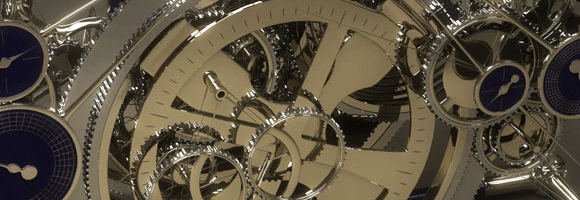
sponges
The 22 oarsmen’s strained muscles are driving the two vessels eastward. Both caiques are laden with sponges, brought to the surface by a party of six divers at their usual fishing grounds, the Tunesian waters. Captain Demetrios El. Kondos, a former masterdiver himself, securely navigates his pair of ships through the Mediterranean, back to the island of Syme near Rhodes, back home. While passing the channel between the islands of Kythera and Crete they get caught in gales and squalls and are driven off course. On the one hand the channel is one of the most frequented shipping routes between the eastern and the western Mediterranean, on the other hand it is a place consisting of sandbars, shoals, and sudden currents, which already made it a famous shipyard for both ancient and modern vessels. Perfectly aware of all that the experienced Captain decides to seek shelter near Port Potamo at the northern end of the almost uninhabitated, rocky and barren islet of Antikythera, where they drop anchor. At 35°52’30”N, 23°18’35”E, to be precise, close to midway between Crete and the Peloponnesus. Once at the very site, right above the submarine shelf locally known as Pinakakia, not to be found on any official chart, they decide to explore the beneaths, because maybe there are sponges.
Elias Stadiatis, one of the divers, vanishes into the depths first, whilst the burning sun lends the Aegaeian its unique flavour. The year is 1900, the 20th century has arrived, this year’s Easter not quite yet. Victoria (1819-1901), Queen of the United Kingdom, of Great Britain and Ireland, and Empress of India is still alive, the Victorian era in full sway, the Empire expanding—making the UK into a superpower—the industrial revolution at its height. Truly a period of significant social, economic, and technological change. Speaking of technology, in contrast to Queen Victoria proto-computer-scientist Charles Babbage (1791-1871) already is dead in 1900. In 1822 Babbage had for the first time discussed the principles of a mechanical calculating engine. He got funds and started to construct the first difference engine: 25,000 parts, 15 tons, eight feet high, never completed. In consequence Gibson & Sterling’s steam-punk alternate reality of “The Difference Engine” (↵1991) fame never comes into being. But in the years 1989-1991, by use of Babbage’s original construction drawings, his second design, the “Difference Engine No. 2”, was built to 19th century tolerances and found to work with astounding accuracy, spilling out results of up to 32 digits length.
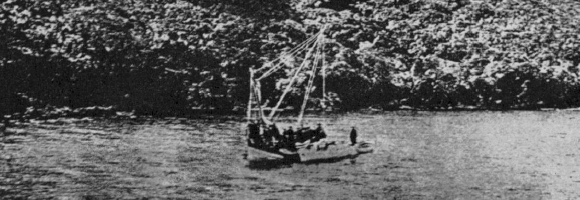
All this does not bother Stadiatis, immersed into the sea, heading down for its bed. And there it is, a compact shadow of some 50 meters in length. The wreck of an ancient Roman commercial cargo ship, lying 42m beneath the surface, just about 30m off shore. Amphorae, marble and bronze statues litter the seabed around the wreck, the rest of its cargo consisted of luxury goods as well: jewellery, pottery, and fine furniture, not to forget the wine once within the amphorae—merchandise, booty, or both. Two millenia have passed since the original addressees have waited for their goods. Hidden in between these treasures there is an artefact yet to be discovered, which will shake our understanding of the classical period. Stadiatis resurfaces, tells his tale and authenticates it by an artefact he has brought up—a larger-than-life sized right arm made of bronze. The Captain himself immediately submerges and makes rough measurements and bearings to be able to again find the treasure ship later on. Then they return home. On 06 November 1900 in Athens they meet Spyridon Staïs, minister of education and a prominent archaeologist. Agreements are made and on 24 November 1900 the divers return to the Roman ship where they immediately start to bring up the artefacts. They work until 30 September 1901. The ship’s contents trigger great excitement among archaeologists, but the bringing-up of the artefacts is stopped then, as the problems of fulfilling the task without heavy equipment are immense. Meanwhile one of the divers has been killed, and another one permanently disabled. Among the brought-up items there are some calcified lumps of corroded bronze—possibly pieces of broken statuary, which are laid aside.
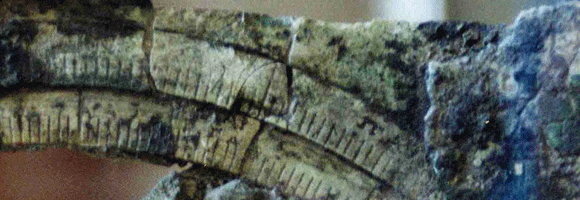
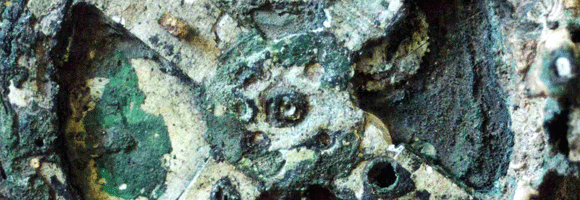
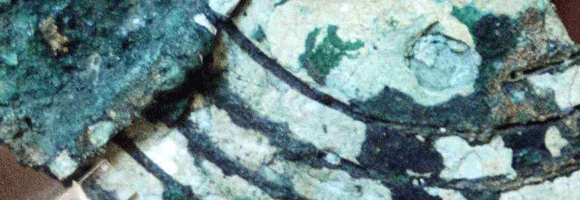
gears
—Derek John de Solla Price (↵1959:60)
On Saturday, 17 May 1902, more or less by accident, Spyridon Staïs scrutinizes the corroded lumps. To his astonishment he not only clearly discovers inscriptions, but cogwheels, their teeth being equilateral triangles—the lumps are fragments of a clocklike mechanism. A suspenseful history of research on the mechanism unfolds, involving a whole cluster of different scholars. The main arguments revolve aorund wether the artefact was an astrolabe or something more complex (see ↵Price 1974:10-12). In summer 1951 British physicist and historian of science ↑Derek John de Solla Price (1922-1983) can lay hands on the device in Athens. Eight years later he publishes a front-page article in Scientific American, which he christened “An ancient Greek computer” (↵Price 1959). Price argues that the Antikythera mechanism is a device for calculating the motions of stars and planets. That means it is the first known analog computer. The article spurs a lot of attention, some react in favor of Price’s theory, others deny the genuineness of the artefact, especially its age. That’s understandable, as the device forcefully demands a complete revision of our perspective on Hellenistic technology. “I feel rather that the whole story of Greek science makes a great deal more sense if we assume that the old view of their rising no higher than the simple Heronic devices was a drastic underestimation that can now be corrected.” (↵Price 1974:12) In 1961 Price returns to Athens with funds and immense equipment. He x-rays the fragments, which enables him to understand and reconstruct the device. It indeed is a computer consisting of 32 gears, including a differential—the latter until now thought to be invented in the 16th century. All this is explained in his “Gears from the Greeks” (↵Price 1974). “The Antikythera mechanism was an arrangement of calibrated differential gears inscribed and configured to produce solar and lunar positions in synchronization with the calendar year. By rotating a shaft protruding from its now-disintegrated wooden case, its owner could read on its front and back dials the progressions of the lunar and synodic months over four-year cycles. He could predict the movement of heavenly bodies regardless of his local government’s erratic calendar.” (↵Rice 1995)
characters
—Rob S. Rice (↵1995)
In 1993 Rob S. Rice remarks, that the “Antikythera mechanism dropped and sank—twice. The first time was around 76 B.C., when the intricate astronomical computer was lost with the rest of a treasure-ship’s cargo. The second time came after Derek De Solla Price analyzed and published its construction and nature decades after its recovery. Since [then] little attention has been paid to our most exciting relic of advanced ancient technology” (↵Rice 1993). It seems that our standard narrative on science, technology, and cosmology of ancient Greece is a fictitious alternate reality, never been in existance. Seen with cold blood the Antikythera mechanism forces us to reconsider e.g. the paramountness of a geocentric cosmology in those times. But standard narratives, once written, are cherished items, hard to overcome. There were some more attempts of reconstruction, by Allan George Bromley, Frank Percival, and Bernard Gardner in the 1990s, and by Michael Wright in the 2000s. Now finally a massive joint program, the ↑Antikythera Mechanism Research Project has taken over, generating fabulous results. In October 2005 it was announced, that more fragments of the Antikythera mechanism have been found, now making a total of about 70 pieces. Sometimes everything seems to conspire in order to let the world remain in style. Re-enter the monstruousness of high-tech devices of Babbage’s times. The Antikythera mechanism’s uniqueness forbids its being removed from its home, the National Archaeological Museum, Athens. So the project hauled in a state-of-the-art 3D-tomography prototype by X-Tek systems, weighing eight tons—quite matching to the overall story’s ambience of steam-, cyberpunk and alternate realities, this device bears the name “Bladerunner”. On 06 June 2006 ↑the project announced first results the imaging system has generated. Until then the known characters inscribed on the mechanism amounted to about 1000, now there are about 2000. 95% of the complete text have been translated until today, but not yet published. Things to come.
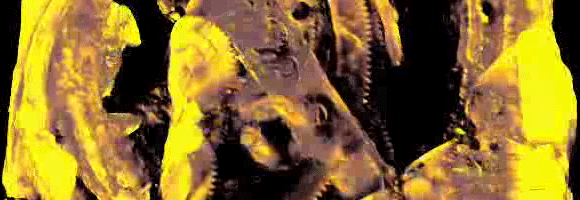
The yellowish picture at the end of the entry is a screencap from a clip showing a 3D-reconstruction of the mechanism’s main fragment, gained from data generated by Bladerunner’s x-ray scrutinization of the fragments. You can clearly see the cogwheels’ teeth.
Initially I was hinted to the Antikythera mechanism via an ↑entry at ↑William Gibson‘s blog. Gibson indeed sems to be fascinated by mechanical computers—there is the already mentioned Babbageian difference engine (↵Gibson & Sterling 1991) and then the ↑Curta calculator so prominently featured in “Pattern Recognition” (↵Gibson 2003). I wonder who will make the race and in whose next novel the Antikythera mechanism surfaces first—in a novel by Gibson or by Stephenson …

